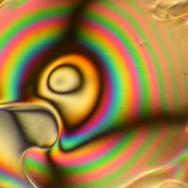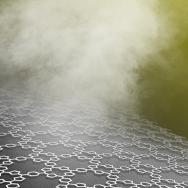Liquid crystals are widely used in technologies such as displays, which manipulate their orientation to display colors across the spectrum.
In traditional displays, liquid crystals are stationary and uniform, free of defects. But that stillness can be altered by adding bacteria to the crystals, creating what scientists and engineers call “living liquid crystals”: materials that can act autonomously. As bacteria swim around the liquid crystal, they generate “defects” that can be used for engineering purposes.
Researchers with the Pritzker School of Molecular Engineering at the University of Chicago, along with colleagues at UChicago-affiliated Argonne National Laboratory, have shown how this material becomes active and disordered through this process, creating floral patterns from the bending instabilities that eventually lead to creation of defects. But the results are not just aesthetic: They are an important step toward understanding how to ultimately control this material for emerging technologies that rely on defect formation.
“The genesis of these instabilities has been a topic of considerable debate, and now we truly understand how this process works, which will ultimately lead to controlling how this material behaves,” said Juan de Pablo, the Liew Family Professor in Molecular Engineering and co-author of the research, recently published in the journal Physical Review X.
Understanding pattern formation
Living liquid crystals are an example of materials that can act on their own. In nature, these materials are responsible for the motility of cells. Proteins within the cells “walk” along the surface of polymer molecules and exert a force that causes displacement and motion.
“There is a lot of interest in these materials because they are complex, beautiful and relevant,” said de Pablo, vice president for national laboratories. “But we want to understand just how motion and transport are generated within them.”
In the lab, one way to create an autonomous material like this is to combine a liquid crystal with bacteria, which then cause disorder among the liquid crystal when they move.
To study how the material becomes active, the researchers combined swimming bacteria with a liquid crystal in two formats: near the bottom surface of a drop suspended from a needle attached to a glass slide, and in a thin, freestanding film.
Though the bacteria and liquid crystal were initially aligned through a magnetic field, when the field was turned off, the bacteria began to move on their own, resulting in “bend instabilities.” These instabilities looked like petals on a flower or branches radiating out from a tree. The number of branches was controlled by the activity of the bacteria.
“The instabilities became more and more prominent as time proceeds, until the system eventually becomes completely disordered,” de Pablo said.
Through these experiments and computational simulations, the researchers discovered how these instabilities form through strain and geometry, and therefore developed a method to create and position the bend instabilities.
Controlling crystals for future technologies
The researchers hope to use this information to be able to fully control these living liquid crystals. That would allow them to eventually create a new kind of microfluidic device that transports fluids autonomously without pumps or pressure, or to create synthetic systems that resemble cells and that could move autonomously from one place to another.
“We have a real possibility to control these materials and use them for interesting new technologies,” de Pablo said.
Other authors include Alexey Snezhko, a physicist at Argonne; Andrey Sokolov, assistant scientist at Argonne; and postdoctoral researchers Ali Mozaffari and Rui Zhang.
Citation: Emergence of Radial Tree of Bend Stripes in Active Nematics. Sokolov et. al. Physical Review X, July 30, 2019. doi: 10.1103/PhysRevX.9.031014
Funding: U.S. Department of Energy
—Article originally appeared on the Pritzker School of Molecular Engineering website.

